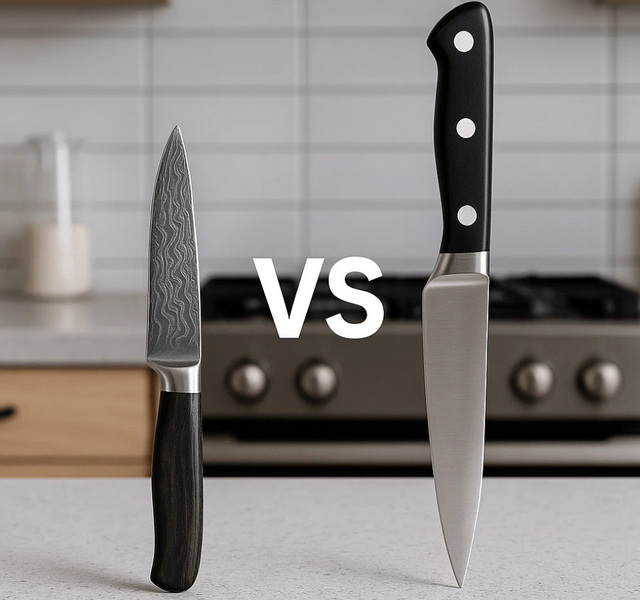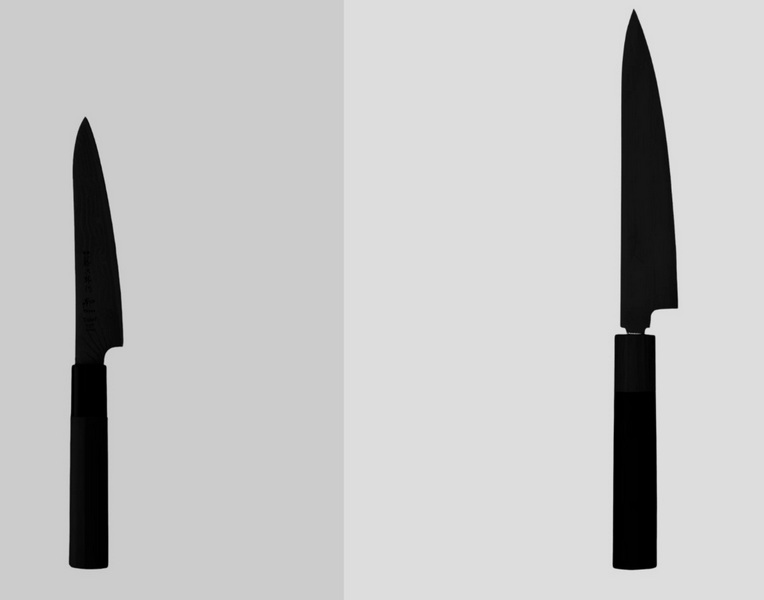- All
- Product Name
- Product Keyword
- Product Model
- Product Summary
- Product Description
- Multi Field Search
Views: 222 Author: Ann Publish Time: 2025-10-23 Origin: Site











Content Menu
● Understanding the Core Differences
● Blade Geometry and Edge Retention
● Handle Ergonomics and Comfort
● Material Choices and Corrosion Resistance
● Care, Maintenance, and Safety
● Usage Scenarios: When to Use Each
● Practical Techniques for Mastery
● Design Considerations for OEM and Branding
>> Presentation of Paring Knife in Marketing:
>> Presentation of Boning Knife in Marketing:
>> Materials and Manufacturing Claims:
● FAQ
>> What is the main difference between a Paring Knife and a Boning Knife?
>> Can I use a Paring Knife for deboning chicken?
>> How should I sharpen a Paring Knife versus a Boning Knife?
>> What materials are best for OEM handles on Paring Knives?
>> How should I store Paring Knives to maximize blade life?
Paring knives and boning knives are two essential tools in any professional kitchen, and choosing the right one can dramatically influence efficiency, safety, and finished quality. This article explores the distinct roles, techniques, and maintenance considerations for Paring Knife and Boning Knife, helping brands, wholesalers, and OEM manufacturers tailor their product guidance for international markets. While the focus remains on practical application, we also highlight how to present clear, compelling content for overseas buyers, including how to describe features, materials, handle ergonomics, and care instructions. Throughout, the term Paring Knife is used extensively to reinforce its importance in everyday culinary tasks, but we will also contrast it with Boning Knife to ensure readers understand the definitive applications of each tool.

At a glance, the Paring Knife is a small, versatile blade designed for delicate precision work. It typically features a 3 to 4.5 inch blade crafted from high-carbon stainless steel or layered Damascus or similar composite materials, depending on the product line. The blade curvature is relatively straight with a subtle curve, enabling controlled slicing, peeling, trimming, and detail work on fruits, vegetables, and garnishes. The Boning Knife, by contrast, is a purpose-built tool with a more flexible, narrow blade ranging from 5 to 6.5 inches, designed to separate meat from bones and remove connective tissue with surgical precision. Its sharpened edge often has a slight curve near the tip to facilitate maneuvering around bones and joints. The difference in blade geometry and stiffness directly affects control, leverage, and safety during use.
- Paring Knife: The small blade requires a fine edge that holds an acute angle to perform delicate tasks like peeling the skin from fruit, deveining shrimp, or coring apples. Most professional paring knives are ground to a 15 to 20-degree per side edge, providing a balance between sharpness and durability. For OEM branding, consider offering edge geometry options such as micro-bevels or stone-washed finishes to communicate premium value.
- Boning Knife: The blade is designed to be flexible enough to bypass cartilage while maintaining strength. A typical boning knife edge is sharpened to a similar or slightly wider angle, commonly around 14 to 18 degrees per side, which supports clean cuts through muscle fibers without excessive blade drift. Bend and flex characteristics are critical for maneuverability around bones and joints.
The Paring Knife handle is usually compact and lightweight, emphasizing precise fingertip control. Ergonomic considerations include a balanced center of gravity, a comfortable grip texture, and a handle shape that minimizes fatigue during extended prep sessions. The Boning Knife handle often prioritizes a slightly longer grip and a fuller tang for leverage when maneuvering around bones. In OEM programs, you can offer multiple handle materials (e.g., pakkawood, G10, stainless steel with soft polymer overlays) and customized shapes to suit regional cooking styles and knife user preferences.
- Stainless Steel: Paring and Boning knives frequently use 1.4116 or 5Cr15MoV variants in budget lines, with higher-end choices using VG-10, S35VN, or sandwiched stainless steel with durable cores. Paring Knives benefit from corrosion resistance and stain resistance in vegetable-heavy tasks; Boning Knives benefit from edge retention and toughness to withstand piercing and slicing through connective tissue.
- Carbon Steel: Some premium Paring Knives leverage carbon steel for high sharpness, though maintenance is more demanding to prevent rust. Boning Knives in carbon steel can offer superb edge retention but require careful drying and oiling after use.
- Damascus and Composite Blades: For premium lines, layered blades can provide striking aesthetics and strong performance. Ensure the OEM story emphasizes manufacturing processes, heat treatment, and edge retention characteristics as part of the value proposition.
- Cleaning: Wash knives by hand with warm water and mild detergent; avoid prolonged soaking and dishwashers that can cause corrosion or handle degradation. For OEM documentation, include clear symbols and multilingual maintenance notes to support global markets.
- Drying and Storage: Dry thoroughly to prevent rust; store in a knife block, on a magnetic strip, or in a protective sheath that keeps blades free from contact. Paring Knives are particularly susceptible to nicks in crowded storage spaces; consider recommending individual blade guards for bulk orders.
- Sharpening: Paring Knife sharpening frequency depends on use, but maintaining a micro-bevel helps preserve a fine edge. Boning Knife sharpening should preserve flexibility and edge integrity; a guided sharpening guide or a dedicated honing rod can be beneficial for users.
- Precision peeling and trimming fruits and vegetables
- Deveining small shrimp, coring berries, removing seeds
- Create decorative garnishes and fruit carvings
- Fine mincing tasks like garlic or shallots in small batches
- Deboning poultry or fish fillets
- Trim fat and sinew from meat cuts
- Skinning and segmenting meat around joints
- Working through bone-in portions where bone contacts are frequent

- Pinch grip and fingertip control: Hold near the blade with the thumb and index finger guiding the edge for meticulous work.
- Push-pull motion with small, controlled movements: Use a light touch to avoid tearing delicate produce.
- Paring with the tip: Lead with the tip for refined control during intricate peeling and trimming.
- Tension and leverage: Apply gentle pressure to separate meat from bone while guiding the blade along natural contours.
- Skiving and trimming: Use short, precise strokes to minimize waste and maximize yield.
- Angle management: Maintain a consistent blade angle to prevent puncturing through bone or unwanted tissue.
- Highlight compact size, precision control, and handling comfort in product descriptions.
- Emphasize edge retention, corrosion resistance, and meticulous sharpening capabilities.
- Use close-up visuals to showcase blade geometry and tip precision.
- Emphasize blade flexibility, knife-to-bone maneuverability, and control for deboning tasks.
- Highlight ergonomic handle design for extended use and reduced hand fatigue.
- Demonstrate usage through high-resolution images showing guiding bones and meat portions.
- Consider internals like blade guards, magnetic sheaths, and anti-scratch packaging to preserve finishes during transport.
- Provide bilingual or multilingual care instructions and usage tips to address international buyers.
- Clearly describe heat-treatment, core material, and forging vs stamping processes.
- Provide test results like hardness (HRC) ranges, corrosion resistance, and edge retention to build buyer confidence.
- Core keyword: Paring Knife
- Related keywords: Boning Knife, kitchen knife, edge retention, blade geometry, hand tool safety, sharpening, honing, knife care, OEM knife manufacturing, knife block packaging, corrosion resistance, heat treatment, cutting technique.
- Use Paring Knife consistently in headings and body text to reinforce relevance, while ensuring natural readability. Diversify with synonyms and natural language to prevent keyword stuffing.
Paring Knife and Boning Knife serve distinct roles in professional kitchens, and understanding their unique blade geometries, edge retention, and ergonomic considerations is essential for both end users and OEM partners. By highlighting the precise applications, maintenance practices, and design possibilities, you can equip buyers with confidence to select the right tool for each task and brand. The Paring Knife stands out for delicate precision, while the Boning Knife excels in separating meat from bone with controlled, purposeful cuts. Together, they form a complementary duo that elevates efficiency, consistency, and safety in professional culinary workflows.

A Paring Knife is a small, versatile blade designed for precision work such as peeling, trimming, and intricate garnish tasks, while a Boning Knife has a longer, more flexible blade optimized for separating meat from bone and removing connective tissue with controlled, accurate cuts.
A Paring Knife is not ideal for deboning larger poultry or bones. For deboning tasks, a Boning Knife provides better maneuverability around joints and bones, reducing waste and improving yield.
Paring Knives benefit from a fine edge with a delicate micro-bevel to maintain precision, typically sharpened at a sharper angle. Boning Knives require a slightly steeper angle to preserve flexibility and edge integrity for bone work; regular maintenance with a guided sharpening method helps sustain performance.
Popular OEM handle materials include pakkawood, G10, and stainless steel with soft polymer overlays. The choice depends on regional preferences for grip feel, moisture resistance, and aesthetics, as well as cost and durability considerations.
Store Paring Knives in a knife block, on a magnetic strip, or in protective sheaths that keep blades from contacting other objects. Individual blade guards and proper drying after washing reduce the risk of nicks, corrosion, and handle degradation.
The Ultimate Professional Knives for Halal Butchery in Middle Eastern Kitchens
Chef Knife Size Guide: Choosing Between 6″, 8″, 10″, And 12″
Custom Knife Handles: How To Design A Chef Knife That Fits Your Hand Perfectly
Chef Knife Surface Treatments Guide: From Polished Migaki To Damascus Patterns
Inside Our Professional Knife Sample Room: Quality You Can See
Universal Knife Block Buying Guide: Modern Acrylic & ABS Knife Holders for Professional Kitchens
Universal Knife Block: The Complete Guide To Modern, Hygienic Knife Storage
The Complete Guide To Red Handle Knife Sets: Style Meets Functionality in The Kitchen
Professional Knives for Halal Butchery And Middle Eastern Cuisine